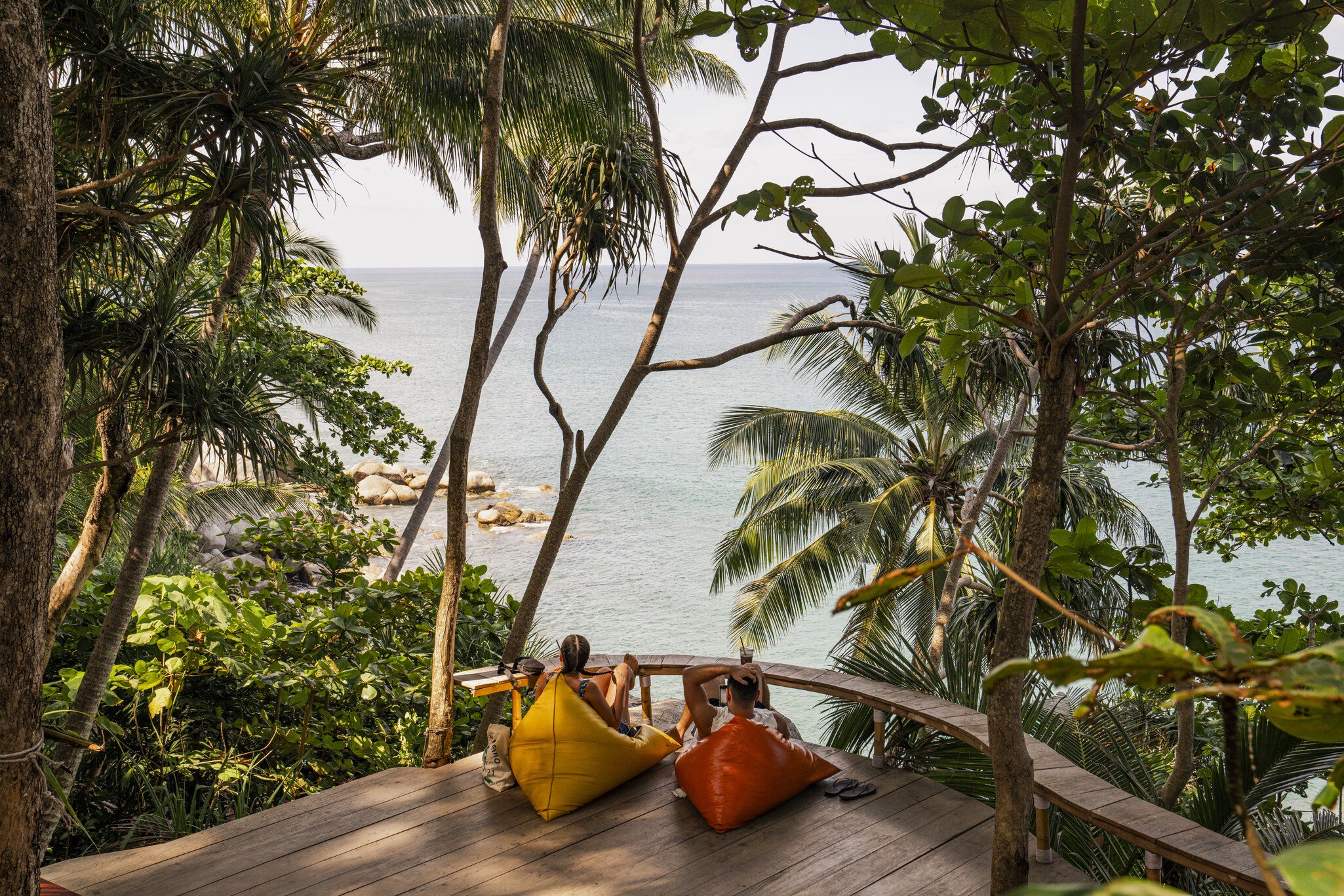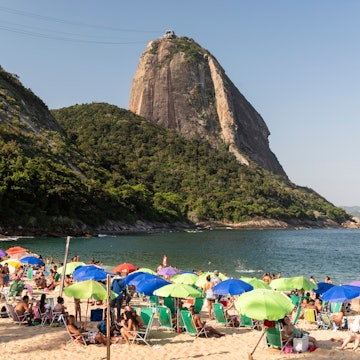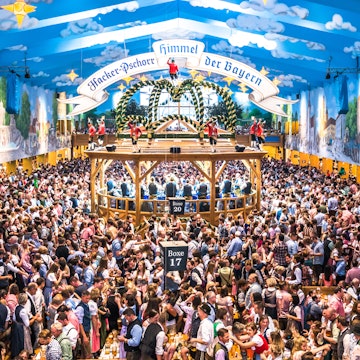

Belo Horizonte, the capital of the Brazilian state Minas Gerais. Luis War/Shutterstock
Belo Horizonte, colloquially referred to as BH (pronounced béaga), is a city that will surprise you with its cultural offerings and vast restaurant and boteco scene where you can try the locally sourced cheese and cachaça.
Upscale neighborhoods like Lourdes and Savassi make great bases for your explorations, with many attractions and tasty restaurants within walking distance. Outside of downtown, Pampulha is the neighborhood with most cultural attractions.
You can spend days in the museums and paying a pilgrimage to the architectural works of Oscar Niemeyer. You'll find his work in Pampulha near the Minerão Stadium. Finally climb up to the heights of Mangabeiras. The city's name becomes clear as the "beautiful horizon" unrolls in every direction.
Here are the top things to do in the vibrant Minas Gerais capital of Belo Horizonte.

1. Sample mineira cuisine at Mercado Central
Anywhere in the country, you can find Brazilians raving about the food in Minas Gerais. The state is famous for its traditional cuisine and you can find restaurants all over Brazil serving comida mineira, heavy fare served in large portions. The must-try dishes are feijão tropeiro (beans mixed with kale, pork sausage and hard-boiled eggs) and tutu à mineira (mashed beans in a thick puree served with crunchy pork loins).
At Mercado Central, you'll find these dishes alongside other famed Minas products like queijo minas, traditional cow's milk cheese, and goiabada, a guava paste or jelly. If you order a "Romeu e Julieta" you will try them together in a classic pairing.
Planning tip: It's easy to lose track of time in this fabulous market so be sure to refresh with a cup of lemonade at Tradicional Limonada, which has been serving the historic market's thirsty shoppers since 1938.
2. Dine your way around Belo Horizonte
Belo Horizonte is teeming with delicious food for every budget. The area between Praça Sete and Praça da Liberdade is best for cheap eats with countless lanchonetes (snack bars), self-serve por kilo restaurants and fast-food places. Further south, the Lourdes and Savassi neighborhoods constitute the epicenter of the city’s fine-dining scene.
Book a table at the city's leading fine-dining restaurant, Glouton, where French fusion with Brazilian ingredients are served in a hip and elegant atmosphere. For something more affordable, the wood-burning fire keeps the soup hot at the homey Dona Lucinha, which serves traditional Minas Gerais family-style dishes. And in Savassi, the community-centered artisanal coffee shop Academia do Café serves savory and sweet treats all day with top-quality coffee (although it closes around 2pm on Sundays).

3. Look out for the beautiful horizon
Since its beginning in the 19th century on top of a simple hamlet, the urban landscape of Belo Horizonte has expanded outward and upward with a skyline full of high-rise condominiums. It's harder to see now from the city center, but you can still find the “beautiful horizon” this city was named for up at Mirante dos Mangabeiras (free), an observation point that is part of a much larger mountaintop park.
Planning tip: Belo Horizonte is best enjoyed by foot, and the city center around Lourdes and Savassi is walkable. However, if you want to venture out to Pampulha or to the outskirts of town, your best bet is to get a taxi or a rideshare, but if you can speak the local language, you'll find buses and Metro are inexpensive alternatives.

4. Admire Oscar Niemeyer's modernist church
Oscar Niemeyer's Igreja de São Francisco de Assis sits alongside the artificial lake in Pampulha. The church design was so unusual, with its undulating concrete roof and modernist paintings by Cândido Portinari, that when officials arrived after its completion in 1958, the bishop refused to consecrate it. This began a 14-year wait for recognition, but now the building shines as one of BH's most interesting architectural sights.
Detour: Other examples of Niemeyer's architecture in Belo Horizonte include the residential Edifício Niemeyer; and the Casa do Baile, a former dance hall (also by Pampulha's lakeshore) with grounds by landscape architect Burle Marx.
5. Dive into Belo Horizonte’s botecos
Home to more than 9000 botecos (small open-air bars), Belo Horizonte is the perfect place to fully immerse yourself in the Brazilian drinking culture which is all about gathering to chat, laugh and join the occasional sing-along.
Walk down the streets of Savassi neighborhood on a Friday or Saturday night and it’s obvious that the people of BH love a good night out. Head to the bottom of Rua da Bahia, where the bars put tables on the sidewalk and the street is buzzing with life most days of the week.
In any neighborhood in the city actually, you'll find locals eating petiscos (sharable plates) and drinking beers while sitting on red plastic chairs. Live music is also used to draw people in, so keep an ear out!
Planning tip: Belo Horizonte celebrates its love of botecos (sometimes spelled buteco) with an annual competition held between April and May. The Comida di Buteco originated in Belo Horizonte but has since spread to over 20 cities, and winners are selected nationally and regionally based on a popular vote.

6. Explore the history of Belo Horizonte at these museums
Many of Belo Horizonte museums and cultural attractions are in the former government buildings surrounding Praça da Liberdade.
Centro Cultural Banco do Brasil (CCBB BH) is a free-to-enter art museum in a grand 1920s building on Praça Liberdade with rotating exhibitions, plus performances and events. There’s also a gastronomic Café do Museu in the courtyard if you want to prolong your visit.
Inside the old railway station, Brazilian history is told through a collection of daily objects at Museu de Artes e Ofícios. For guided tours of Brazil's legendary stadium, head to Mineirão & Museu Brasileiro do Futebol, where you can also peruse exhibits on football history.
In the Cidade Jardim neighborhood, the Museu Histórico Abílio Barreto tell the story of the city's founding through the lens of a preserved colonial farmhouse. For a contemporary chronicle of Minas Gerais culture and mining history over three centuries, check out the Memorial Minas Gerais – Vale.

7. Join the Mercado Novo scene
One of Belo Horizonte's youngest markets with a distinctly modern flavor opened its doors in 2019. Today it is a trendy take on the traditional Mercado Central in downtown BH. Mercado Novo houses cool restaurants, stylish wine and cocktail bars, plus there are shops selling bespoke scented candles and clothes by independent designers.
The city’s young professionals and alternative types flock here on the weekends to enjoy smoked eggs and salted fish at Cozinha Tupis and wash it all down with cold dark lagers and IPAs from local brewery Cervejaria Viela or cachaça-based drinks at Cachaçaria Lamparina.
Planning tip: The market stays open at night every day except Sunday.
8. Take a day trip to historic Sabará
Once one of the region's wealthiest cities during the height of the gold rush in the 18th century, Sabará is now a charmingly preserved town 25km outside of Belo Horizonte. It makes an ideal day trip and a chance to get a sense of the traditional Portuguese architecture of Brazil's colonial era.
Begin in Praça Santa Rita with its pretty gazebo and work your way around the church circuit to Matriz de NS de Conceição which blends Portuguese baroque with Asian styles and Igreja NS do Carmo, with pieces by the 18th-century sculptor Aleijadinho.
The Museu do Ouro is a small museum in the old gold foundry that explains the story of the town's most prosperous era. Also stop by the Teatro Municipal, a small but elegant opera house.

9. Taste jabuticaba in Sabará
Among the many different fruits you'll find in Brazil, jabuticaba is one of the sweetest and strangest surprises. The dark grape-resembling fruit grows directly on the tree bark and you eat it by popping the thick purple skin and extracting the gooey center.
Many Brazilians are obsessed with this berry, which is sometimes hard to find due to its short shelf life. However, Sabará is home to the annual Jabuticaba Festival that takes place every year in November. The town was once filled with jabuticaba trees, but now only a few remain. There's one in front of the Amarzém São Judas shop, which also sells specialty items like jabuticaba jams and ice creams.
Local tip: You will find locals selling jabuticaba in wheelbarrows but don't be put off if the stock looks dirty. Sellers avoid washing the fruit because water quickens the speedy decomposition process. Just give it a quick clean yourself and you're ready to try one.

10. Visit the Instituto de Arte Contemporânea Inhotim
Latin America’s largest open-air art gallery, Inhotim has more than 700 artworks scattered around a 140-hectare botanic garden.
It was founded in the 1980s by one of Brazil's richest people, the controversial mining magnate Bernardo de Mello Paz. In 2017, Mello was sentenced for receiving donations intended for the museum. He denied these accusations and was later freed of all charges.
Located in the municipality of Brumadinho, which is still rebuilding after a tragic flood in 2019, Inhotim is 58km southeast of Belo Horizonte. There is ample parking if you take a car, but the bus company Viacão Atual runs once-per-day buses to and from the museum.
In one day you will get a taste, but unless you're going for a land speed record, it will be impossible to see everything. Museum completionists should consider the three-day pass and perhaps book a stay nearby.
Planning tip: Bring a bathing suit to enjoy Piscina, which is both an artwork by Jorge Macchi and an actual swimming pool.
This article was adapted from Lonely Planet’s Brazil guidebook, published in October 2025.













